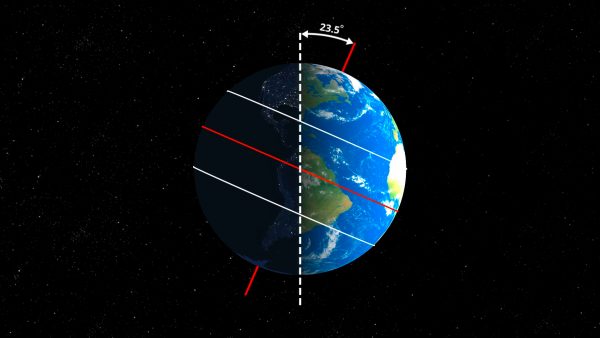Earth’s Axis Definition
Earth's axis, an imaginary line around which Earth rotates, tilts at 23.5°, causing seasonal changes. For example, this tilt leads to varying sunlight intensities, affecting weather patterns.
View Lesson on Causes of Seasons
Become a member to get full access to our entire library of learning videos, reading material, quiz games, simple DIY activities & more.
Become a member to get full access to our entire library of learning videos, quiz games, & more.
Plans & Pricingto watch this full video.

Access All Videos
and Lessons, No Limits.
Access All Videos

No credit card required,
takes 7 sec to signup.
No card required

Ready-to-go lessons
that save you time.
Ready-to-go lessons
If you are on a school computer or network, ask your tech person to whitelist these URLs:
*.wistia.com, fast.wistia.com, fast.wistia.net, embedwistia-a.akamaihd.net
Sometimes a simple refresh solves this issue. If you need further help, contact us.
Causes of Seasons
Fun Facts
- Earth's axis tilt causes summer in the Northern Hemisphere during June.
- While the tilt of Earth's axis affects the number of hours of daylight, the equator always has 12 hours of daylight every day of the year.
- New York City gets 15 hours of daylight in summer due to the tilt of Earth's axis.
Why Do We Need To Know About Earth's Axis
Learning about Earth’s axis is really important for many jobs. For example, astronauts and engineers need to know about Earth’s tilt and orbit when they plan trips to Mars to make sure everything goes safely and smoothly. This shows how important the Earth’s axis is for exploring space.
Also, knowing about the Earth’s tilt is key for jobs in environmental science, farming, moving goods around the world, and making solar power. By understanding how the tilt changes seasons, sunlight, and weather, people in these jobs can make smart choices, like when to grow food and how to set up solar panels.
Frequently Asked Questions
Check out the Full Lesson on Causes of Seasons
In this lesson, we learn that:
- Earth spins on its axis, which is tilted by 23.5 degrees.
- This tilt causes places on Earth to experience different intensities of sunlight at different times of year.
- That leads to changes in temperature, which results in seasons.
Related Topics
- Bacteria Definition
- Batteries Definition
- Biodiversity Definition
- Biotechnology Definition
- Chemical Change Definition
- Chloroplast Definition
- Chromosome Definition
- Competition Definition
- Definition Of Engineering
- Definition Of Nutrients
- Definition Of Science
- Dichotomous Key Definition
- Distillation Definition
- Earth’s Axis Definition
- Earth’s Rotation Definition
- Ecosphere Definition
- Erosion Definition
- Food Web Definition
- Force Definition
- Geosphere Definition
- Gravity Definition
- Group Behavior Definition
- Humidity Definition
- Inherited Traits Definition
- Landform Definition
- Latitude Definition
- Liquid Nitrogen Definition
- Lunar Eclipse Definition
- Mutualism Definition
- Natural Resource Definition
- Non-renewable Energy Definition
- Plant Definition
- Pollinator Definition
- Renewable Energy Definition
- Renewable Resource Definition
- Seed Definition
- Seeing Definition
- Senses Definition
- Smelling Definition
- States Of Matter Definition
- Surface Runoff Definition
- Taxonomy Definition
- Tectonic Plates Definition
- Texture Definition
- Transform Boundary Definition
- Virus Definition
- Water Erosion Definition
- Weather Map Definition
Start a Free Trial Today. Get a $5 Amazon Gift Card!
Teachers! Start a free trial & we'll send your gift card within 1 day. Only cards left. Try it now.
Select Grade
Select Subject
This email is associated with a Science Kit subscription. Kit subscriptions are managed on this separate page: Manage Subscription

-
Download InvoiceScience & Math$/yr
-
Download InvoiceScience Only$/yr

access all lessons
• No credit card required •
"My students loved the videos. I started the video subscription in May and used them as a review before the state test, which I know contributed to 100% of my class passing the state test."
Rhonda Fox 4th Grade Teacher, Ocala, Florida
• No credit card required •
"My students loved the videos. I started the video subscription in May and used them as a review before the state test, which I know contributed to 100% of my class passing the state test."
Rhonda Fox 4th Grade Teacher, Ocala, Florida
• No credit card required •
Already a member? Sign In
* no credit card required *

* no credit card required *
* no credit card required *


no credit card required
Skip, I will use a 3 day free trial
Enjoy your free 30 days trial
-
Unlimited access to our full library
of videos & lessons for grades K-5. -
You won’t be billed unless you keep your
account open past your 14-day free trial. -
You can cancel anytime in 1 click on the
manage account page or by emailing us.
-
Unlimited access to our full library of videos & lessons for grades K-5.
-
You won't be billed unless you keep your account open past 14 days.
-
You can cancel anytime in 1-click on the manage account page.
Cancel anytime in 1-click on the manage account page before the trial ends and you won't be charged.
Otherwise you will pay just $10 CAD/month for the service as long as your account is open.
Cancel anytime on the manage account page in 1-click and you won't be charged.
Otherwise you will pay $10 CAD/month for the service as long as your account is open.
We just sent you a confirmation email. Enjoy!
DoneWe use cookies to make your experience with this site better. By using this site you agree to our use of cookies. Click "Decline" to delete and block any non-essential cookies for this site on this specific property, device, and browser. Please read our privacy policy for more information on the cookies we use.Learn More
We use cookies to improve your experience. By using this site, you agree to our use of cookies. Click "Decline" to block non-essential cookies. See our privacy policy for details.Learn More



























































































































